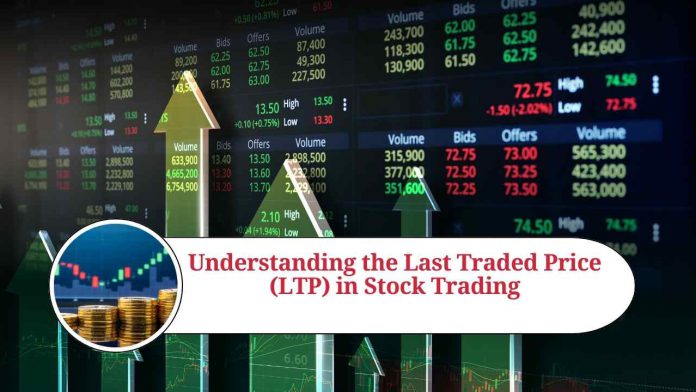Introduction
In the world of stock trading, there are various terminologies and metrics that investors and traders need to familiarize themselves with. One such metric is the Last Traded Price (LTP). The Last Traded Price is a crucial piece of information that provides insights into the recent transaction price of a particular stock. In this blog, we will delve deeper into the concept of Last Traded Price and understand its significance in stock trading.
What is Last Traded Price (LTP)? The Last Traded Price refers to the most recent price at which a particular stock was traded on an exchange. It represents the last transaction price at which a buyer and a seller agreed upon. The LTP is updated in real-time and constantly changes as new trades take place.
Significance of Last Traded Price:
- Real-Time Market Value: The LTP provides investors with real-time information about the current market value of a stock. By knowing the LTP, traders can assess the stock’s recent price trend and make informed decisions about buying or selling.
- Reference Price for Trades: The LTP serves as a reference point for investors when placing buy or sell orders. Traders can set their desired price based on the LTP to execute their orders at a more favorable price. For example, if the LTP is higher than the desired purchase price, a trader may choose to place a limit order at a lower price.
- Analyzing Price Movements: By observing the LTP over a period, investors can analyze price movements and identify trends in the stock’s performance. This information can be crucial for technical analysis, where traders study historical price data to predict future price movements.
- Volatility Assessment: LTP helps in assessing the volatility of a stock. If the LTP changes rapidly and frequently, it indicates higher volatility, implying greater potential for price fluctuations. Traders seeking short-term gains may find volatile stocks more appealing.
- Tracking Market Depth: The LTP also provides insights into the depth of the market. By observing the LTP alongside the bid and ask prices, traders can gauge the demand and supply dynamics for a particular stock. This information can be valuable when assessing liquidity and making trading decisions.
Conclusion
In stock trading, the Last Traded Price (LTP) plays a pivotal role in providing investors and traders with up-to-date information about the recent transaction price of a stock. By understanding the LTP, traders can make informed decisions, set desired price levels, and track market trends. It serves as a valuable reference point for executing trades and analyzing price movements. Keeping an eye on the LTP is essential for anyone seeking success in the dynamic world of stock trading.
Read more useful content:
- How to invest in mutual funds
- All about mutual funds-types & importance
- The Power of SIP Investment in Mutual Funds
Frequently Asked Questions (FAQs)
Q1: What does Last Traded Price (LTP) mean?
A1: The Last Traded Price refers to the most recent price at which a particular stock was traded on an exchange. It represents the last transaction price agreed upon by a buyer and a seller.
Q2: How is the Last Traded Price determined?
A2: The Last Traded Price is determined by the most recent transaction that took place in the market. When a buyer and a seller agree on a price, and the transaction is completed, that price becomes the new LTP.
Q3: Why is the Last Traded Price important for stock traders?
A3: The Last Traded Price is important for stock traders as it provides real-time information about the current market value of a stock. It serves as a reference point for executing trades, assessing price movements, and making informed decisions about buying or selling.
Q4: How frequently does the Last Traded Price change?
A4: The Last Traded Price changes in real-time as new trades take place. It can change within seconds or even milliseconds, depending on the liquidity and trading activity of the stock.
Q5: How can I use the Last Traded Price to place trades?
A5: The Last Traded Price can be used as a reference point when placing buy or sell orders. Traders can set their desired price based on the LTP to execute orders at a more favorable price. For example, if the LTP is higher than the desired purchase price, a trader may choose to place a limit order at a lower price.
Q6: Can the Last Traded Price be used to predict future price movements?
A6: While the Last Traded Price provides information about recent trades, it alone cannot predict future price movements. However, by analyzing historical LTP data and combining it with other technical indicators and fundamental analysis, traders can make more informed predictions about potential price trends.
Q7: How does the Last Traded Price relate to stock market volatility?
A7: The Last Traded Price can help assess the volatility of a stock. If the LTP changes rapidly and frequently, it indicates higher volatility, suggesting greater potential for price fluctuations. Traders seeking short-term gains may find volatile stocks more appealing.
Q8: Can I track the depth of the market using the Last Traded Price?
A8: Yes, by observing the Last Traded Price alongside the bid and ask prices, traders can gauge the demand and supply dynamics for a particular stock. This information can help assess the liquidity of a stock and make trading decisions accordingly.
Q9: Where can I find the Last Traded Price of a stock?
A9: The Last Traded Price of a stock can be found on various financial platforms, trading websites, and stock market data providers. It is usually displayed alongside other relevant information, such as the stock’s symbol, volume, and price change.
Q10: Is the Last Traded Price the same as the closing price?
A10: No, the Last Traded Price is not necessarily the same as the closing price. The Last Traded Price represents the most recent transaction price, whereas the closing price refers to the final price at which a stock traded before the market closed for the day.














